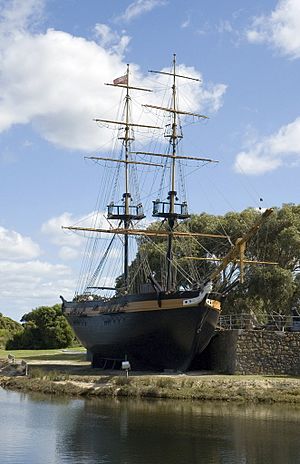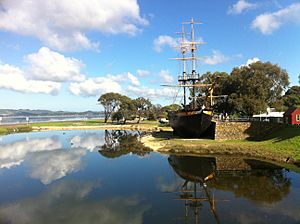Amity (brig) facts for kids

Amity replica at Albany, Western Australia
|
|
Quick facts for kids History |
|
|---|---|
| Name | Amity |
| Builder | St John's, New Brunswick |
| Launched | 1816 |
| Fate | Wrecked near Vansittart Island on 18 June 1845 |
| General characteristics | |
| Type | Brig |
| Tonnage | 148 tons burthen |
| Length | 75 feet 6 inches |
| Beam | 21 feet 5 inches |
The Amity was a sailing ship called a brig. It weighed 148 tons. This ship was famous for its important trips of exploration and settlement in Australia during the early 1800s. The Amity was built in New Brunswick in 1816. For several years, it worked as a merchant ship, trading goods between America and Britain. It came to Australia in 1824.
Contents
Early Journeys of the Amity
Voyage to Van Diemen's Land
The Amity was a 148-ton brig launched in 1816 at Saint John, New Brunswick. In 1823, a Scottish family, the Ralstons, bought the ship. They wanted to use it for their journey to Van Diemen's Land, which is now Tasmania.
Captain McMeckan was in charge of the ship. It left Stranraer in southern Scotland on November 15, 1823. The ship sailed to Dublin, then across the Atlantic Ocean to Rio de Janeiro. It arrived in Hobart exactly five months later, on April 15, 1824.
There were 21 passengers on board, including Robert Ralston, his wife Elizabeth, their two sons, and six daughters. The ship also carried cargo and farm animals. These animals included two bulls and four cows from Scotland. After this journey, Mr. Ralston sold the ship to the Government of New South Wales in Sydney. The government then used the Amity for exploring and carrying supplies.
First Settlers to Moreton Bay
The Amity carried the first European settlers to Queensland. This happened after John Oxley suggested in 1823 that Redcliffe would be a good place for a penal colony. A penal colony was a settlement for convicts.
On September 14, 1824, Lieutenant Henry Miller led a group of about 70 people to Moreton Bay. This group included soldiers from the 40th Foot Regiment, 29 convicts, explorers, and their families.
Places Named After the Ship
The town of Amity and the area of Amity Point are on North Stradbroke Island near Brisbane, Queensland. These places are named after the Amity ship. There is even a Brig Street in the area.
In Brisbane, there are six streets named Amity. On the Sunshine Coast, there are two more. Amity Park is just outside Brisbane to the north. There is also an Amity Recreation Reserve and an Amity Point Reserve in the area. In September 1991, a special memorial was put up in Redcliffe. It has four bronze plaques, and one of them shows the Amity ship.
Establishing a Settlement at King George Sound
In 1826, Governor Ralph Darling gave instructions for the Amity to sail to Western Australia. Major Edmund Lockyer was in command of the ship. He started the first European settlement there. This settlement was a military base at King George Sound, which is now called Albany. The settlement was first named Frederick Town.
The expedition included Major Lockyer, two military officers, 18 soldiers, 23 convicts, and a surgeon named Isaac Scott Nind. They also brought farm animals and supplies. These supplies were meant to last for about six months. The group got off the ship on Boxing Day, December 26, 1826.
Arrival at Swan River Colony
On September 22, 1829, the Amity arrived at Fremantle. It had sailed from Singapore with 15 passengers and crew members. The Amity was the eighth ship to arrive in the new Swan River Colony.
The Amity's Final Journey
Shipwreck Near Vansittart Island
By 1844, the Amity was used to transport cattle. It carried cattle from Port Albert in Victoria across Bass Strait to Hobart in Tasmania. The Amity was wrecked on June 18, 1845. It ran aground on a sandbar that was not on any maps. This sandbar is now called Vansittart Shoals (40°16′S 148°25′E / 40.267°S 148.417°E). It is near Vansittart Island, which is north of Van Diemen's Land (now Tasmania).
Captain William Marr was sailing the Amity from Hobart to Port Albert on June 14, 1845. The ship had no cargo, only nine crew members and one passenger. They faced a strong storm as they entered Bass Strait. The ship hit a sandbank about twelve miles (19 km) off Shoaly Bay. This was on the south-east coast of Flinders Island, likely the Vansittart Shoals.
As the ship broke apart, everyone left it. They all made it safely to the island, but both of their small boats were damaged. The people who were shipwrecked found a group of seal hunters. The sealers lent them another boat. Everyone except Captain Marr headed for Cape Portland, Tasmania. Captain Marr was later rescued by another ship called the schooner Letitia.
A Replica of the Amity
In 1972, people in Albany started talking about building a copy of the Amity. They wanted it to be ready for the town's 150th birthday celebrations in 1976. After getting money and doing research, construction began in 1975. Stan Austin, a local boat builder, was in charge of the project. Pieter van de Brugge was the main shipwright.
Today, a full-sized replica of the Amity is on land. It is part of the Museum of the Great Southern. This museum is in the Stirling Historical Precinct on Princess Royal Drive in Albany. It looks out over Princess Royal Harbour. The replica is placed to make it seem like it is floating in the water. You can take audio tours of the replica every day.


